Do you have a question about the Bernina 900 and is the answer not in the manual?
Details the color-coding of wires in the mains lead for safety.
Instructions for connecting wires to the correct terminals in the plug.
Specifies the required fuse rating based on the plug type used.
Identifies and lists all major parts and components of the sewing machine.
Advice on positioning the machine and user for comfortable sewing.
Fundamental rules for guiding material correctly during sewing.
Details settings for stitch width, length, and needle position for straight stitch.
Explains how to adjust needle position for various sewing tasks.
Instructions on using the reverse sewing button for securing stitches.
Guidance on securing stitches effectively in thick seams.
Settings for zigzag stitch width, length, and needle position.
Method for trimming seams using zigzag stitch for a neat finish.
Proper hand positioning and guiding for achieving a neat zigzag finish.
How to set the machine for various plain stitch patterns using selector knob.
Settings and guidance for performing satin stitch with close zigzag.
Advice on using paper underlay for embroidery to prevent material tightening.
Technique to prevent Jersey material from waving during zigzag stitching.
Settings for creating jersey hems suitable for underwear.
Instructions for sewing a hem on Jersey without a tuck.
Instructions for sewing a hem on Jersey with a tuck.
Guidance on correctly holding an extra thread for Jersey sewing.
Settings for stitch width, length, and needle position for patching Jersey.
Correct technique for holding scissors when trimming close to stitches.
Steps for patching Jersey, including zigzag stitching and cutting.
Instructions for creating a quick seam on knitted fabrics.
Method for sewing a flat seam on cotton jersey for underwear.
Steps for sewing a gusset seam, often used in garment construction.
General advice for sewing seams on various knitted fabrics.
Settings for creating stretch seams for ski trousers and elastic fabrics.
Instructions for creating a stretch seam specifically for jersey underwear hems.
Settings for the Vari-Overlock stitch for sewing and trimming.
Explains the use of the overlock seam for joining and trimming materials.
Instructions for creating a shell edging, often used on garments.
Method for sewing an elastic band, ensuring stretchability.
Technique for attaching lace to Jersey fabric using zigzag stitch.
Applying lace and inserts into fabric using straight and zigzag stitches.
Method for creating a narrow edging, often for finishing seams.
Settings for sewing with elastic thread, including width and length.
Tips for using elastic thread, especially regarding tension and gathering.
Settings for gathering material using zigzag stitch.
Method for gathering material using a pearl cord and zigzag stitch.
Alternative method for gathering using straight stitches.
Settings for blind hem stitch, including width, length, and needle position.
Detailed instructions on how to perform a blind hem stitch correctly.
Guidance on how to hold and guide the fabric for effective blind hemming.
Settings for basting stitches, including width, length, and needle position.
Using the magic needle with its two eyes for basting.
Method for securing basting threads at the beginning and end of seams.
Machine settings required for sewing buttonholes, including stitch width and length.
Step-by-step guide on how to sew buttonholes on the machine.
How to adjust stitch density for buttonholes based on fabric type.
Procedure for inserting and using reinforcing cord for stronger buttonholes.
Using running stitch for patching material, including settings and steps.
A modern darning technique using running stitch with specific settings.
How to use cordonnet as the upper thread for decorative seams.
Using cordonnet thread in the bobbin case for decorative effects.
Instructions for performing a saddle stitch, suitable for soft materials.
Using the universal stitch for attractive fancy saddle stitching.
Settings for darning, including stitch width, length, and needle position.
Proper technique for holding the darning hoop for best results.
Details on the three runs of darning and common faults.
Settings for darning fine socks, sleeves, and similar items.
Correct hand positioning for holding work while darning socks.
Instructions for darning woollens and terry cloth, including settings.
First step of darning with wool: applying the wool threads.
Second step of darning with wool: oversewing the applied wool threads.
Settings for sewing buttons, including stitch width, length, and position.
Step-by-step instructions for sewing buttons using the machine.
How to create a shank for buttons using a darning needle.
Settings for inserting zips, including stitch width, length, and position.
Recommended method for inserting zips for a neat finish.
Essential preliminary steps before starting tailor tacking.
Settings for tacking using sewing, basting, or darning thread.
Using tailor tacking to transfer patterns onto fabric.
Settings for using the hemmer foot, including stitch width and length.
Initial steps for sewing with the hemmer foot.
Proper technique for guiding fabric when using the hemmer.
Method for sewing corners using the hemmer foot.
Settings for the shell hemmer, including stitch width and length.
Technique for sewing corners using the shell hemmer.
Settings for the lap hemmer, including stitch width and length.
First operation steps for using the lap hemmer.
Second operation steps for using the lap hemmer.
Settings for the gatherer foot, including stitch width and length.
Understanding how stitch length affects the amount of gather.
Preparation steps for appliqué work, including tracing and transferring designs.
Techniques for guiding the work with or without a frame during appliqué.
Step-by-step sequence for completing appliqué work.
How to sew rectangular corners in appliqué work.
How to sew pointed corners in appliqué work.
How to sew blunt corners and curves in appliqué work.
Techniques for multi-coloured appliqué, including layering and trimming.
Settings for satin stitch embroidery, including stitch width and length.
How to sew satin stitch corners with different designs.
Creating borders and scallops using satin stitch embroidery.
Sewing a straight border using satin stitch.
Sewing a narrow border using satin stitch and pearl cord.
Settings for using a double needle, including stitch width and length.
Proper threading procedure for the double needle.
Instructions for sewing pintucks using a pintuck foot and double needle.
How to sew corners when creating pintucks with a double needle.
Creating fancy patterns using a double needle without pintucks.
Using the single hemstitch needle for decorative stitching.
Creating decorative ruches and entre-deux using hemstitches.
Using hemstitching to create appliqué effects with pre-embroidered fabric.
Creating trellis work borders using metallic thread and hemstitching.
Instructions for performing an ordinary hemstitch.
How to perform a zigzag hemstitch.
Instructions for performing a fancy hemstitch.
How to create monograms without using a special foot.
Proper technique for guiding the work when creating monograms.
How to use the buttonhole gauge to mark buttonholes accurately.
Using the hem gauge for marking hem widths accurately.
Details the color-coding of wires in the mains lead for safety.
Instructions for connecting wires to the correct terminals in the plug.
Specifies the required fuse rating based on the plug type used.
Identifies and lists all major parts and components of the sewing machine.
Advice on positioning the machine and user for comfortable sewing.
Fundamental rules for guiding material correctly during sewing.
Details settings for stitch width, length, and needle position for straight stitch.
Explains how to adjust needle position for various sewing tasks.
Instructions on using the reverse sewing button for securing stitches.
Guidance on securing stitches effectively in thick seams.
Settings for zigzag stitch width, length, and needle position.
Method for trimming seams using zigzag stitch for a neat finish.
Proper hand positioning and guiding for achieving a neat zigzag finish.
How to set the machine for various plain stitch patterns using selector knob.
Settings and guidance for performing satin stitch with close zigzag.
Advice on using paper underlay for embroidery to prevent material tightening.
Technique to prevent Jersey material from waving during zigzag stitching.
Settings for creating jersey hems suitable for underwear.
Instructions for sewing a hem on Jersey without a tuck.
Instructions for sewing a hem on Jersey with a tuck.
Guidance on correctly holding an extra thread for Jersey sewing.
Settings for stitch width, length, and needle position for patching Jersey.
Correct technique for holding scissors when trimming close to stitches.
Steps for patching Jersey, including zigzag stitching and cutting.
Instructions for creating a quick seam on knitted fabrics.
Method for sewing a flat seam on cotton jersey for underwear.
Steps for sewing a gusset seam, often used in garment construction.
General advice for sewing seams on various knitted fabrics.
Settings for creating stretch seams for ski trousers and elastic fabrics.
Instructions for creating a stretch seam specifically for jersey underwear hems.
Settings for the Vari-Overlock stitch for sewing and trimming.
Explains the use of the overlock seam for joining and trimming materials.
Instructions for creating a shell edging, often used on garments.
Method for sewing an elastic band, ensuring stretchability.
Technique for attaching lace to Jersey fabric using zigzag stitch.
Applying lace and inserts into fabric using straight and zigzag stitches.
Method for creating a narrow edging, often for finishing seams.
Settings for sewing with elastic thread, including width and length.
Tips for using elastic thread, especially regarding tension and gathering.
Settings for gathering material using zigzag stitch.
Method for gathering material using a pearl cord and zigzag stitch.
Alternative method for gathering using straight stitches.
Settings for blind hem stitch, including width, length, and needle position.
Detailed instructions on how to perform a blind hem stitch correctly.
Guidance on how to hold and guide the fabric for effective blind hemming.
Settings for basting stitches, including width, length, and needle position.
Using the magic needle with its two eyes for basting.
Method for securing basting threads at the beginning and end of seams.
Machine settings required for sewing buttonholes, including stitch width and length.
Step-by-step guide on how to sew buttonholes on the machine.
How to adjust stitch density for buttonholes based on fabric type.
Procedure for inserting and using reinforcing cord for stronger buttonholes.
Using running stitch for patching material, including settings and steps.
A modern darning technique using running stitch with specific settings.
How to use cordonnet as the upper thread for decorative seams.
Using cordonnet thread in the bobbin case for decorative effects.
Instructions for performing a saddle stitch, suitable for soft materials.
Using the universal stitch for attractive fancy saddle stitching.
Settings for darning, including stitch width, length, and needle position.
Proper technique for holding the darning hoop for best results.
Details on the three runs of darning and common faults.
Settings for darning fine socks, sleeves, and similar items.
Correct hand positioning for holding work while darning socks.
Instructions for darning woollens and terry cloth, including settings.
First step of darning with wool: applying the wool threads.
Second step of darning with wool: oversewing the applied wool threads.
Settings for sewing buttons, including stitch width, length, and position.
Step-by-step instructions for sewing buttons using the machine.
How to create a shank for buttons using a darning needle.
Settings for inserting zips, including stitch width, length, and position.
Recommended method for inserting zips for a neat finish.
Essential preliminary steps before starting tailor tacking.
Settings for tacking using sewing, basting, or darning thread.
Using tailor tacking to transfer patterns onto fabric.
Settings for using the hemmer foot, including stitch width and length.
Initial steps for sewing with the hemmer foot.
Proper technique for guiding fabric when using the hemmer.
Method for sewing corners using the hemmer foot.
Settings for the shell hemmer, including stitch width and length.
Technique for sewing corners using the shell hemmer.
Settings for the lap hemmer, including stitch width and length.
First operation steps for using the lap hemmer.
Second operation steps for using the lap hemmer.
Settings for the gatherer foot, including stitch width and length.
Understanding how stitch length affects the amount of gather.
Preparation steps for appliqué work, including tracing and transferring designs.
Techniques for guiding the work with or without a frame during appliqué.
Step-by-step sequence for completing appliqué work.
How to sew rectangular corners in appliqué work.
How to sew pointed corners in appliqué work.
How to sew blunt corners and curves in appliqué work.
Techniques for multi-coloured appliqué, including layering and trimming.
Settings for satin stitch embroidery, including stitch width and length.
How to sew satin stitch corners with different designs.
Creating borders and scallops using satin stitch embroidery.
Sewing a straight border using satin stitch.
Sewing a narrow border using satin stitch and pearl cord.
Settings for using a double needle, including stitch width and length.
Proper threading procedure for the double needle.
Instructions for sewing pintucks using a pintuck foot and double needle.
How to sew corners when creating pintucks with a double needle.
Creating fancy patterns using a double needle without pintucks.
Using the single hemstitch needle for decorative stitching.
Creating decorative ruches and entre-deux using hemstitches.
Using hemstitching to create appliqué effects with pre-embroidered fabric.
Creating trellis work borders using metallic thread and hemstitching.
Instructions for performing an ordinary hemstitch.
How to perform a zigzag hemstitch.
Instructions for performing a fancy hemstitch.
How to create monograms without using a special foot.
Proper technique for guiding the work when creating monograms.
How to use the buttonhole gauge to mark buttonholes accurately.
Using the hem gauge for marking hem widths accurately.
| Type | Sewing and Embroidery Machine |
|---|---|
| BERNINA Dual Feed | Yes |
| Automatic Thread Cutter | Yes |
| Built-in Memory | Yes |
| USB Port | Yes |
| Knee Lifter | Yes |
| BERNINA Stitch Regulator (BSR) | Yes |
| Touchscreen | Yes |
| Stitch Width | 9 mm |
| Display | 7-inch color touchscreen |

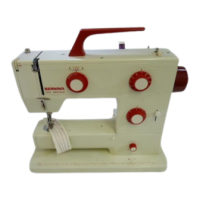


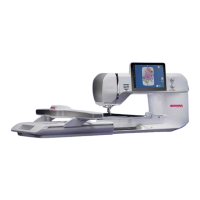

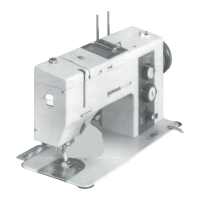


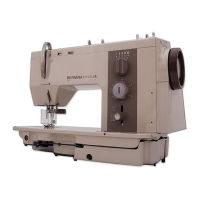
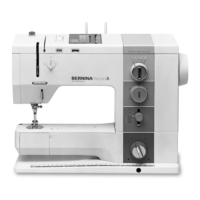
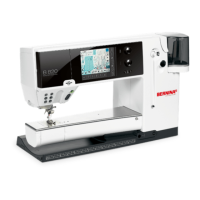
